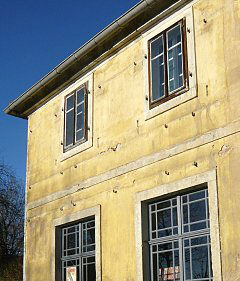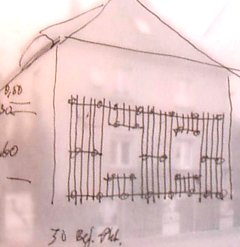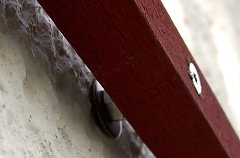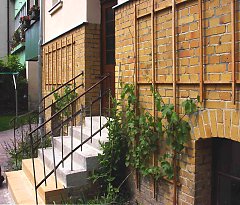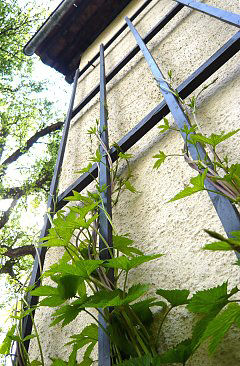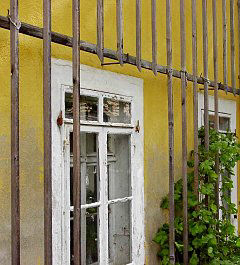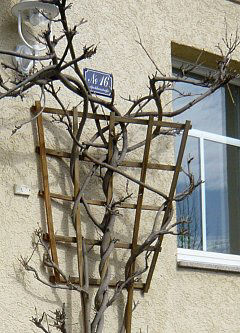Tips for Attaching Trellises
Which trellis mounts fit with which trellises? How many mounts are needed per trellis? What is a reasonable distance between trellis and wall? We address all this here. Whatever type of wall you have, there is always a fastening solution! *This page is still under construction.
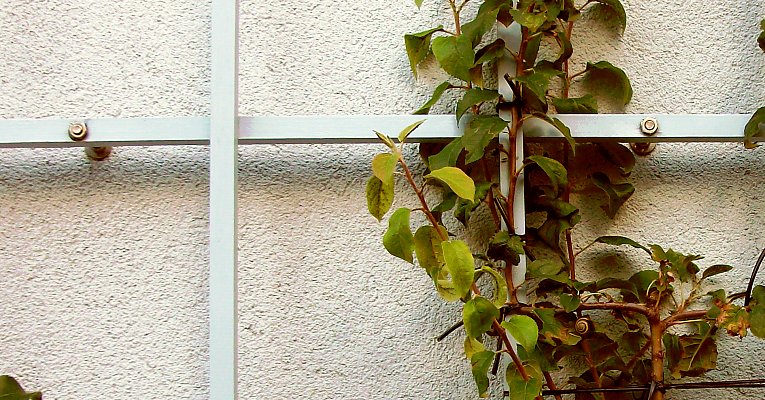
How will the trellis be attached?
Originally, trellises were hung on pre-cemented wall hooks and secured with bast or a similar, fibrous material. This meant that the trellis could be easily removed for repairs. But, even with modern anchors and mounts, a trellis can be relatively easily detached if, say, the façade needs renovating. Almost all of FassadenGrün's holders also provide a seal for the drill hole.
Usually, it is the lateral laths which are anchored to the wall and, once secure, the vertical laths are then positioned and screwed in over them. Very large trellises, multiple meters wide, are divided into individual panels or trellis grids, which can then be removed separately. We recommend that you measure and demarcate the points at which you want to drill rather than taking a spontaneous approach. More info under the section 'Step by Step.'
How many mounts?
The number of wall mounts depends on the trellis' width. For details on the density and distance between attachment points, refer to the product sheets of your specific trellis anchors. With lighter mounts such as AS 0855, you can improve the stability of the trellis by increasing the number of attachment points.
Wall Gap and Wall Clearance
When fitting a trellis you should also be aware of providing sufficient distance between it and the wall so that your plants do not feel suffocated. First, the gap between the wall and the back of the trellis cross beam is measured. Depending on the chosen anchoring mount, it is 1-5 cm. The actual wall distance of the plants is calculated from this wall gap and the sum of the wood cross sections. This is, with a lath thickness of 27/27, another 5-6 cm. For this, usually 1-5 cm wall gap and accordingly 6-12 cm wall distance are sufficient. More can be found on the individual climbing plant pages.
Small Wall Gap
A small wall gap of about 5-6 cm (as with the trellis mount "Mini") is a low-cost option and works for plants whose shoots do not have the tendency to meander and curl behind the trellis; otherwise, the annual removal of such shoots becomes very tedious. The actual wall gap is then only about 1-2 cm.
Average Wall Gap
An average wall distance of about 10 cm is usual for most creepers and climbers, especially to allow annual shoots to be set behind the trellis. This then reduces your maintenance work because there is no need totie them up. Plant trellising is made easier if the stems are simply tucked into the trellis rather than having to be tied. With the 'Classic' mount, the stems of some annual or light plants (like hops) have the freedom to wrap around the lattice laths. The actual wall gap is then about 5cm.
Greater Wall Gap
A greater wall distance of about 15 cm reduces the risk of mildew for susceptible plants, such as climbing roses and grapevines. In general, however, the issue should not be overestimated here, especially for large, older plants. The shoots can easily become entangled with each other and create their own optimal wall spacing by freely growing in the space provided, between the wall and trellis, in which case the trellis only anchors and ventilates the branch structure. Particularly large wall gaps can be provided with the AS 12XX0, (our longest mount) but even then, the space created will not exceed 7-9 cm.
Problematic Insulation
For lightly loaded trellises on walls with up to 6 (12) cm of insulation, the anchor bolt for ETICS is often sufficient. The AS 12XX8 or AS 12XX6 are suitable for massive, more heavily loaded trellises, for denser insulation up to 12cm thick, and also for greater wall distances.
Preventing Damage
Regardless of the distance between the wall and trellis, perennial shoots that form the plant structure must never grow behind or wrap around the trellis. Otherwise, the plants' growth, and more specifically girth, can and very often will damage the trellis or growth structure, as with this wisteria to the right.

